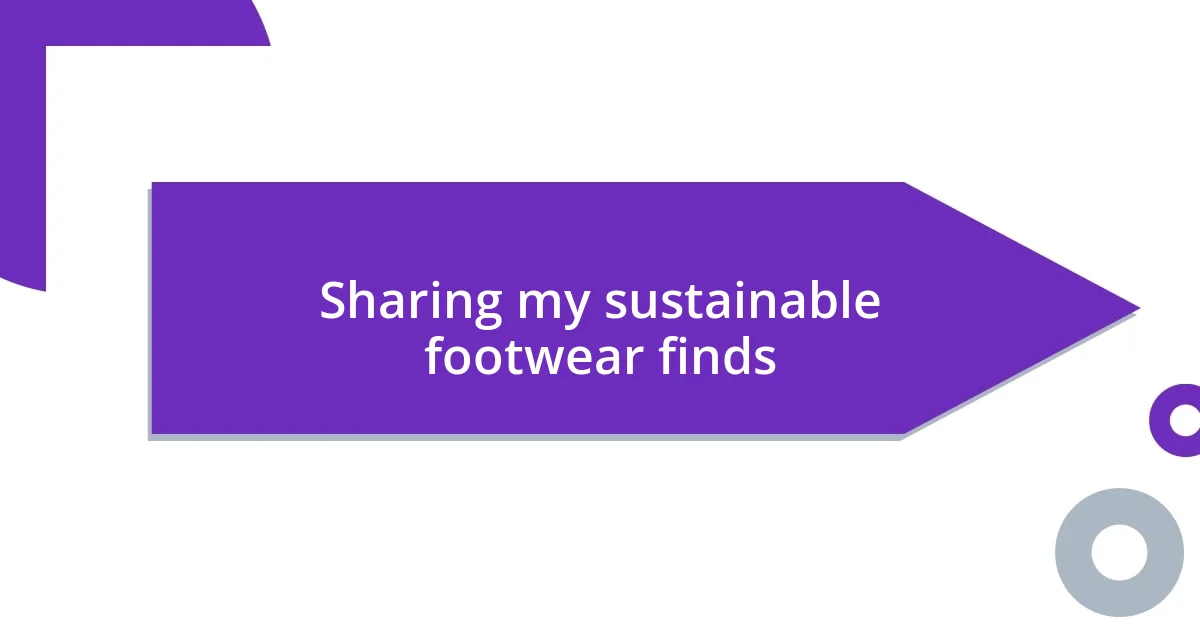Key takeaways:
- The realization of the environmental impact of fast fashion motivates a personal shift towards sustainable footwear choices.
- Understanding sustainable fashion requires awareness of eco-friendly materials, ethical production, and the importance of brand transparency.
- Engaging with sustainable brands and their stories fosters a deeper connection and empowers informed purchasing decisions that reflect personal values.

My journey towards sustainable footwear
As I began to question my consumption habits, I felt a need to align my values with my purchases. One day, while sifting through my closet, I stumbled upon a pair of sneakers that had seen better days. I couldn’t help but wonder—what story did these shoes tell? Were they part of a cycle that contributed to fast fashion and environmental harm? This realization sparked my journey towards sustainable footwear.
During my quest, I vividly remember attending a local sustainability fair. A passionate brand representative shared the journey of their eco-friendly shoes, made from recycled materials and produced in fair-wage factories. Listening to her speak about the impact we could make with our choices struck a chord deep within me. I found myself picturing my own footprint—was I leaving a path of awareness or one of ignorance?
My exploration didn’t stop there. I started to seek out brands that resonated with my newfound beliefs, which was surprisingly empowering. One day, after ordering a pair of ethically made sandals, I opened the box to find a heartwarming note from the artisan who crafted them. I laughed to myself—who knew that choosing sustainable footwear could create such a personal connection? It made me realize that every step I took in those shoes could be a statement of change.

Understanding sustainable fashion
Understanding sustainable fashion is about grasping the deeper implications of our choices as consumers. I personally realized that sustainable fashion is not merely a trend; it’s a movement toward a more responsible approach to clothing and footwear. At times, I found it overwhelming, as I wrestled with questions about what materials were genuinely eco-friendly and whether my purchasing decisions were making a real impact.
Here are some key aspects to consider:
- Eco-Friendly Materials: Sustainable brands often use organic, recycled, or renewable materials, which helps reduce environmental harm.
- Ethical Production: Many brands prioritize fair labor practices, ensuring workers are paid fairly and treated with respect.
- Durability: Sustainable footwear is usually designed to last, reducing the need for frequent replacements and lessening waste.
- Transparency: Companies committed to sustainability often share their production processes and sourcing details, allowing consumers to make informed choices.
It’s these insights that guide me as I navigate my way through the sometimes confusing world of sustainable fashion. Each small step I take, whether by choosing a responsibly made shoe or engaging in conversations about sustainability, adds to a larger narrative—one that shifts our collective mindset toward more conscientious living.

Researching eco-friendly materials
Researching eco-friendly materials is a deep dive into a world where sustainability and style intersect. One of my lightbulb moments came when I discovered vegan leather. I was blown away to learn that materials derived from plants, like pineapple leaves and apple peels, can mimic the look and feel of traditional leather without the environmental toll. This discovery not only piqued my curiosity but also ignited a desire to seek out footwear options that combined fashion with eco-consciousness.
As I explored further, I stumbled upon recycled plastics transformed into footwear. I remember feeling a mix of relief and excitement when I found out that some brands use ocean plastics to create trendy sneakers. This not only diverts waste from oceans but also tells a powerful story about recycling and innovation. I wondered how many other materials were being repurposed to create something beautiful, and I couldn’t help but feel a sense of hope for the future of fashion.
These materials didn’t just inspire me; they challenged me to rethink my choices. When selecting new shoes for an upcoming vacation, I found myself scanning labels and researching brands to prioritize those utilizing sustainable materials. It felt rewarding to know that my purchases would support a healthier planet. It’s more than just shopping; it’s about making informed decisions that reflect a commitment to our environment.
| Material Type | Benefits |
|---|---|
| Organic Cotton | Biodegradable, reduces pesticide use |
| Recycled Polyester | Reduces plastic waste, less energy in production |
| Vegan Leather | Animal-friendly, often made from renewable resources |

Identifying ethical footwear brands
Identifying ethical footwear brands can feel like unearthing hidden treasures in a crowded market. I vividly recall the moment I came across a brand that not only shared its supply chain transparency but also detailed how they supported communities where they sourced materials. It struck me how empowering it felt to know my footwear choice contributed positively to workers’ lives instead of exploiting them.
One of the key indicators I found helpful is looking for certifications like Fair Trade or B Corp. When I spotted these labels on a new pair of shoes, I felt a rush of excitement—here was a brand that truly valued ethics over just profit. It made me wonder: how much more impactful could our choices be if we all prioritized brands that are genuinely committed to ethical practices?
As I delved deeper into my search, the stories behind the brands began to resonate with me. There was one particular company that shared their journey of starting small and gradually growing into a significant force for good. I remember feeling a sense of connection and inspiration as I read their founder’s story. It reminded me that every purchase isn’t just about the product—it’s about supporting a vision.

Evaluating brand sustainability practices
Evaluating a brand’s sustainability practices can sometimes feel overwhelming, but I’ve learned to focus on a few key aspects. For me, it’s essential to look beyond flashy marketing and investigate how a company sources its materials and treats its workers. I remember when I first started checking for environmental impact reports. Seeing concrete data about a brand’s carbon footprint made me feel more informed and empowered in my choices.
When I started looking at sustainability certifications, it became easier to differentiate between genuine efforts and greenwashing—when brands exaggerate their eco-friendly credentials. I recall coming across a brand that showcased its dedication to reducing waste through a circular economy model, where they encourage customers to return old shoes for recycling. The idea that my worn-out shoes could get a second life filled me with excitement and a sense of responsibility.
One practice that often stands out to me is how brands communicate their sustainability journey. During my research, I found a brand that shared regular updates on its environmental initiatives, along with success stories that celebrated their milestones. This transparency fostered trust and made me want to champion their mission. I began to ask myself: How can we support brands that not only aspire to change the industry, but also involve us in their journey toward sustainability?

Making informed purchasing decisions
Making informed purchasing decisions requires a blend of research and intuition. I remember the first time I stood in a store, holding a pair of shoes that claimed to be eco-friendly. I instinctively thought, “What does eco-friendly even mean in this context?” That gut feeling pushed me to check online for reviews and material sources, helping me steer clear of impulsive choices.
As I explored various brands, I found that their stories mattered significantly. One day, I stumbled upon a brand that highlighted a partnership with local artisans, showcasing their craftsmanship through video stories. This drew me in—suddenly, my shoes weren’t just shoes; they were part of a rich narrative. I often think: how many stories are we missing by not exploring where our purchases come from?
In my shopping journeys, engaging with communities on social media has opened my eyes to valuable feedback. I recall a passionate debate on a dedicated sustainability forum about a brand’s manufacturing process. The insights shared there helped clarify my doubts. It made me ponder—how much can we learn from each other’s experiences to make more informed choices?

Sharing my sustainable footwear finds
Finding sustainable footwear brands has been quite a journey for me, filled with unexpected finds. I still vividly remember the thrill of discovering a small company that specializes in biodegradable sneakers. The moment I slipped them on, I couldn’t shake the feeling of knowing that every step I took was a step in the right direction for the environment. It made me wonder: how often do we pause to appreciate the impact of our choices?
Another memorable encounter was with a brand that focuses on repurposing materials from old shoes to create new styles. I had the chance to attend a pop-up event where I saw firsthand how they transformed discarded materials into beautiful footwear. It was inspiring to see the creativity involved, and I couldn’t help but feel a wave of hope. This experience left me questioning how we can encourage more brands to innovate in sustainable ways.
I also found a relatively unknown brand that donates a pair of shoes for every pair purchased. I was captivated by their mission and decided to buy a pair, imagining that my purchase would have a direct and positive impact. As I wore my new shoes, I felt a sense of connection to someone in need. It made me think: isn’t it empowering to know that our choices can not only reflect our values but also make a difference in someone else’s life?














